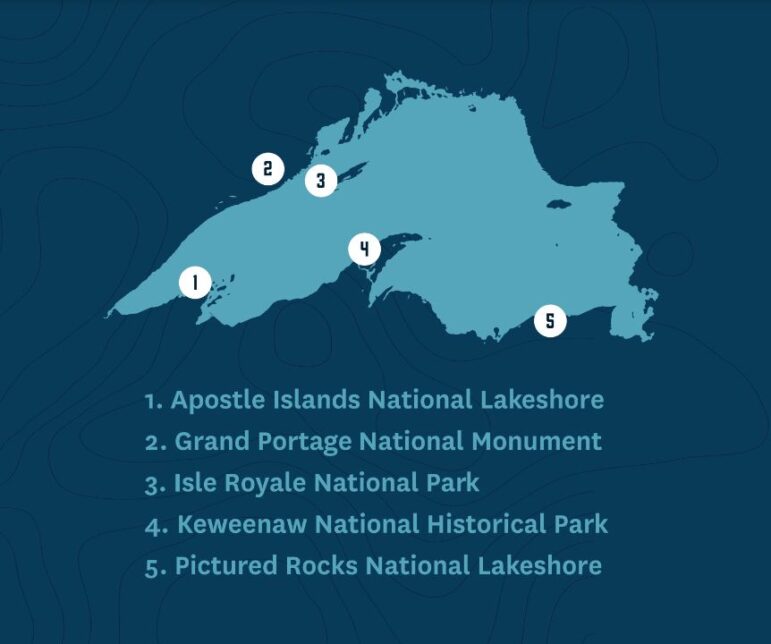
National Parks of Lake Superior Foundation.
All five of Lake Superior’s National Parks are getting solar panels and electric vehicles.By GENEVIEVE FOX
Capital News Service
A group of supporters has started an initiative to bring solar power and electric vehicles to all five of Lake Superior’s national parks.
The National Parks of Lake Superior Foundation plans to install solar panels and use batteries and electric cars on Lake Superior’s five national parks. The project is expected to cost $15 million to $17 million.
The foundation is the only non-profit fundraising partner of the five national parks. It is the first such organization to implement the solar and electric revamp at national parks.
Lake Superior’s national parks are Apostle Islands National Lakeshore, Grand Portage National Monument, Isle Royale National Park, Keweenaw National Historical Park and Pictured Rocks National Lakeshore. They have about 3 million visitors a year.
The project began when Tom Irvine, executive director of the foundation, and Eric Dayton, founder of Askov Finlayson, a clothing company committed to “keeping the north cold,” discussed how to make the parks cleaner and environmentally healthier. Dayton, as an early investor, made the project possible.
Dinah Swain, the partnership director for the foundation, wants to create a leading example of what other parks in the United States should do. Integrating carbon-free methods in the park will inspire others to become more environmentally friendly in their own lives, she said.
Noting that the United Nations has a goal is to become carbon neutral, meaning that emissions created must be offset by emissions reduced elsewhere, by 2050, Swain said that needs to happen more quickly.
Willdan Energy Solutions, an engineering services company, and Energy + Environmental Economics (E3), an energy consulting firm, have partnered with the project. They collected onsite data from each park to recommend how the parks should decarbonize by 2030.
The parks heavily rely on fossil fuels for power. Decarbonizing them provides visitors with a cleaner environment, Swain said.
And it saves money. The foundation reports that Willdan and E3 discovered that the project will reduce energy costs by $2.7 million and cut carbon emissions by 93% over 25 years.
Many of these technologies, like the air source heat pumps and solar panels, can be bought at Home Depot, Swain said. With the help of home centers and other retailers, people can become carbon neutral within their own homes.
“All those people will see what can be done and hopefully will take it back to their communities,” Swain said.
Supporters are especially excited about addressing the needs of Isle Royale National Park, one of the most remote, wildest parks in the contiguous 48 states, Swain said.
“When you go there, it’s supposed to be this super wonderful wild place but you hear diesel generators in the back and that kind of ruins the experience,” Swain said. “Not to mention diesel going back and forth over Lake Superior is such a hazardous situation if it ever spilled.”
Every park has a different energy-saving plan to fit its needs, Swain said.
Nineteen buildings at Apostle Islands National Lakeshore will get new heat pumps and energy-efficient LEDs. Power will be supplied by up to 11 solar arrays and 12 vehicles will be replaced with electric ones.
Ten buildings at Grand Portage National Monument will get new heat pumps and energy-efficient LEDs. Power will be supplied to one solar array and 10 vehicles will be replaced with electric ones.
Eighty-one buildings at Isle Royale National Park will get new heat pumps and energy-efficient LEDs. Power will be supplied to three off-grid locations, or locations not connected to the electrical grid, with backup diesel generators for emergencies. Those locations are Mott, Windigo and Rock Harbor. Seven vehicles will be replaced with electric vehicles.
Six buildings at Keweenaw National Historical Park will get new heat pumps and energy-efficient LEDs. Power will be supplied to one solar array and two vehicles will be replaced with electric ones.
Fifteen buildings at Pictured Rocks National Lakeshore will get new heat pumps and energy-efficient LEDs. Power will be supplied to one solar array and all vehicles will be replaced with electric ones.
Electric vehicle charging stations will also be installed at each park.
The project is also looking into electric-powered water transportation to reduce carbon emissions, Swain said. “The technology is not quite there yet but we’re keeping an eye on it.”
She hopes the project will begin this year.

Steve De Neef
Isle Royale is known for its isolation and primitive wilderness.
W/GRAND PORTAGE WATERFALL
Visitors to Grand Portage National Monument explore theAmerican fur trade and the stories told by Native Americans.